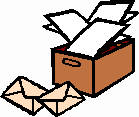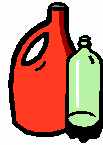 Every day people put bins, bags, and containers of recyclables at the curb for collection or drive them to a drop-off center. What actually happens to the material after the truck pulls away? Each material undergoes a different process on its route along the recycling trail.
Every day people put bins, bags, and containers of recyclables at the curb for collection or drive them to a drop-off center. What actually happens to the material after the truck pulls away? Each material undergoes a different process on its route along the recycling trail.
Glass
Glass recycling focuses on container glass (e.g., glass bottles and jars). Glass manufacturers regularly use recycled glass in the production of new containers with percentages of recycled material ranging from 7%-50%, depending on the  manufacturer
manufacturer
- Separate container glass from such items as windows, mirrors or ceramics because the manufacturing process is very different for items other than containers.
- After a hauler picks up the glass, it is taken to a material recovery facility where the glass is separated by color, cleaned, and then crushed (cullet).
- The cullet is shipped to a manufacturer who melts it (at temperatures up to 2,700°F) and mixes it with "virgin" material to make new containers.
It’s that simple to create a closed loop glass recycling system that requires less energy, uses fewer natural resources, and produces fewer pollutants than manufacturing glass from virgin materials.
Metal Containers
Metal containers can be made from recycled steel or aluminum. Recycling metal containers is environmentally friendly and easy.
- The recycler separates the aluminum from the steel cans by using an industrial sized magnet to pick up the steel cans.
- The separated cans are crushed, baled together, and sent on to the appropriate mill.
- At the mill the cans are exposed to high heat and melted down. The resulting material is used to make more products from steel or aluminum.
When one ton of steel is recycled, 2,500 pounds of iron ore, 1,400 pounds of coal and 120 pounds of limestone are conserved. Using recycled aluminum to make aluminum cans saves 95% of the energy compared to producing aluminum cans from ore.
Paper
Newspaper, white paper, mixed paper, cardboard, and telephone books can be recycled. White paper is the most valuable because of its quality and versatility. The process for creating new products from recycled paper is simple.
- The paper is separated by type/grade.
The separated paper is then put into a large vat (similar to a giant kitchen mixer) and mixed with water creating a product called "slurry".
- The slurry is spread on racks and big rollers push all the water out. Once dry, the paper is then rolled up for later cutting into whatever size is needed for the new product.
- The slurry is also the basis for paperboard (used for cereal boxes, etc.), corrugated cardboard, telephone books, and newsprint.
- By adding wood or cotton fibers the slurry is turned into office-grade paper.
Unlike glass or steel, paper degrades each time it is recycled. For this reason, not all recycled paper goes directly to manufacturers to make more paper. Some of it is used to create insulation, animal bedding or in composting.
Plastics
 Plastic is made from fossil fuel (approximately 30% oil and 70% natural gas), a non-renewable resource. There are many different types of plastic on the market. Look at the bottom of plastic containers for one of the symbols. This symbol indicates the type of plastic that was used to make the container.
Plastic is made from fossil fuel (approximately 30% oil and 70% natural gas), a non-renewable resource. There are many different types of plastic on the market. Look at the bottom of plastic containers for one of the symbols. This symbol indicates the type of plastic that was used to make the container.
#1 PET or PETE (polyethylene terephthalate) is the most recycled plastic. Recycled PET is used to make bottles for cleaning products or other non-food containers, egg cartons, strapping, surfboards, sailboat hulls, industrial paints, and fiber products (t-shirts, jackets and carpets).
 # 2 HDPE (high-density polyethylene) is the most widely used householdplastic. Recycled HDPE is used to make plastic lumber, base cups for soft drink bottles, flower pots, plastic toys, traffic barrier cones, bottle carriers, trash cans, detergent bottles, garbage bags and grocery bags.
# 2 HDPE (high-density polyethylene) is the most widely used householdplastic. Recycled HDPE is used to make plastic lumber, base cups for soft drink bottles, flower pots, plastic toys, traffic barrier cones, bottle carriers, trash cans, detergent bottles, garbage bags and grocery bags.
# 3 PVC (polyvinyl chloride) is the plastic used in flooring, plumbing, shower curtains, house siding and garden hoses. Though PVC is harder to recycle, it can be processed to make drainage piping, fencing, handrails and house siding.
#4 LDPE (low-density polyethylene) is used to make cellophane wrap, disposable diaper liners, plastic bags, and squeeze bottles. The nature of products made from LDPE make it very difficult to recycle.
# 5 PP (polypropylene) is a component in tubes, automotive battery casings, and long underwear. Though not often recycled, there is the potential to create auto parts, batteries, bird feeders, furniture, pails, water meter boxes, bag dispensers, golf equipment, carpets, recycling containers,  and industrial fibers.
and industrial fibers.
# 6 PS (polystyrene or polystyrene foam) is found in coffee cups, plastic cutlery, take-out food packaging, egg cartons, and packaging peanuts. Polystyrene can be recycled into more polystyrene products as well as insulation, plastic lumber, license plate frames, cafeteria trays, and hard plastic pens.
Other Plastics
Other plastic is any type of plastic that is not listed above. The recycling of these plastics is more complicated. The recycling community will need to learn ways to handle the newer technologies.
No matter the type, plastic recycling follows a similar path.
- Collected plastic is sent to a reclaimer who will sort (by type of plastic), grind, and clean the plastic.
- The cleaned and sorted plastic is sent to a manufacturer who will use it as "feedstock" (i.e., a component of the manufacturing process) to create new products.
Check with your county recycling coordinator to confirm which plastics are recycled in your area. Additionally, some grocery stores will accept plastic shopping bags for recycling, and shipping businesses will accept Styrofoam peanuts for recycling.
For more information, contact The Waste Diversion Division at 410-537-3314.